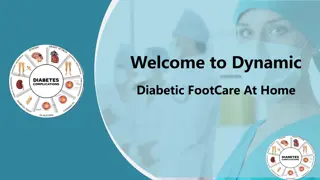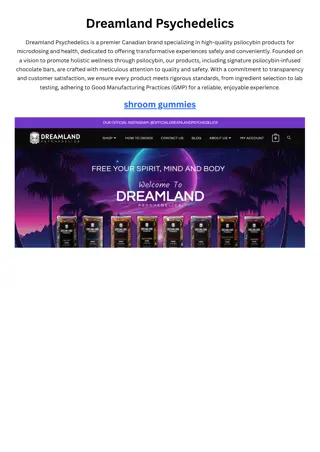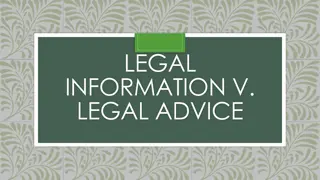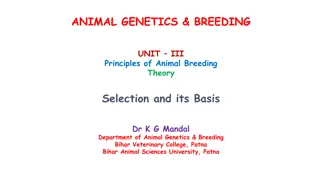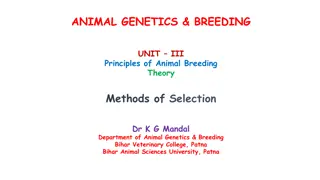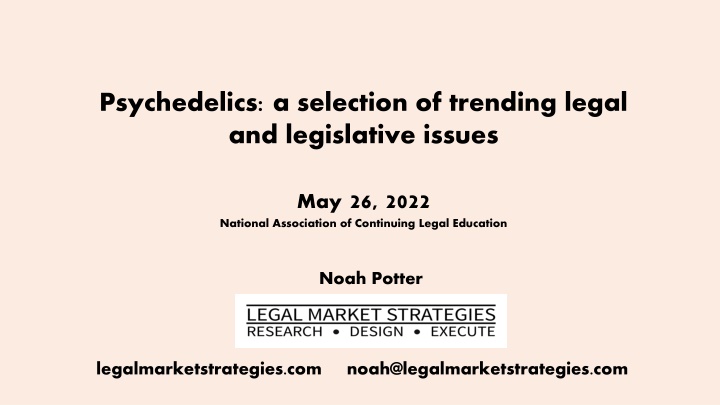
Psychedelics: Current Legal and Legislative Trends in America
Examining the evolving landscape of psychedelic law and regulation, from historical movements to present-day initiatives. Explore the definition, effects, and legal frameworks surrounding psychedelics in the U.S., shedding light on their unique properties and potential social impact.
Download Presentation

Please find below an Image/Link to download the presentation.
The content on the website is provided AS IS for your information and personal use only. It may not be sold, licensed, or shared on other websites without obtaining consent from the author. If you encounter any issues during the download, it is possible that the publisher has removed the file from their server.
You are allowed to download the files provided on this website for personal or commercial use, subject to the condition that they are used lawfully. All files are the property of their respective owners.
The content on the website is provided AS IS for your information and personal use only. It may not be sold, licensed, or shared on other websites without obtaining consent from the author.
E N D
Presentation Transcript
Psychedelics: a selection of trending legal and legislative issues May 26, 2022 National Association of Continuing Legal Education Noah Potter Text Description automatically generated with medium confidence legalmarketstrategies.com noah@legalmarketstrategies.com
About me My first experience with psychedelics was in the spring of 1990 as a high school senior. I immediately perceived a political significance to the psychedelic experience. As an undergraduate political science in the spring of 1993, I became aware of the ibogaine legalization movement, and co-founded Cures Not Wars, the first (only?) direct action psychedelic legalization group. I applied to law school with the goal of legalizing psychedelics. Among other things: I became chair of the New York City Bar Association s Committee on Drugs and the Law in 2006 after stints in the Health Law and Mental Health Law committees: I organized multiple cutting-edge programs, including, in April of 2008, the first public discussion of NYPD s practice of arresting young men of color for personal-use amounts of cannabis (the issue that drove cannabis legalization in New York), and in September 2017 a panel on the legal history of psychedelics. I articulated a vision of psychedelics as a unique field of legal study in 2010 when I created The New Amsterdam Psychedelic Law Blog. I advised the Decriminalize Denver campaign in the stage of drafting the ballot initiative that passed in 2019 and launched the nationwide psychedelic movement for state- and local-level psychedelic law change. My twenty+ years as a commercial litigator and appellate attorney inform my perspective on psychedelic markets. See Psychedelic Markets of the Future. https://chacruna.net/psychedelic-markets-future/ 2
What are psychedelics? Imprecise designation of various psychoactive substances: generally refers to lysergic acid diethylamide, psilocybin, DMT, mescaline, ibogaine, and bufotenine. Generally includes MDMA and ketamine, although both differ in their action and effects from the classic psychedelics. Difficulty in formulating term to describe them: Officially still hallucinogens in the federal and state controlled substances acts. Psychedelic coined by Dr. Humphry Osmond in 1957; one among many candidates. From Greek; means approximately mind-manifesting. Entheogen, meaning approximately generating God within is popular among certain constituencies. Categorically different from other psychoactive substances in their subjective effects: Michael Pollan s book How to Change Your Mind, Michael Pollan 2018 uses the term ineffable to describe a psychedelic experience. Can be disorienting and challenge prior conceptions of self and relationships with others. 3
Definition of psychedelic American Psychological Association definition of hallucinogen [same as psychedelic ]: n. a substance capable of producing a sensory effect (visual, auditory, olfactory, gustatory, or tactile) in the absence of an actual stimulus. Because they produce alterations in perception, cognition, and mood, hallucinogens are also called psychedelic drugs or psychedelics (from the Greek, meaning mind- manifesting ). They are a group of heterogeneous compounds, many of which are naturally occurring; others are produced synthetically. Many hallucinogens are structurally similar to one of several neurotransmitters, which may be used as a mechanism of categorization. . https://dictionary.apa.org/hallucinogen [accessed May 24, 2022] 4
History Examples of use outside of Western biomedicine Carvings of mushrooms in North Africa 7000-8000 B.C.E. Eleusinian Mysteries in Ancient Greece Psilocybin mushrooms in Central America and Mexico before arrival of Europeans Iboga in Gabon Ayahuasca in South America 5
Awareness of psychedelics in European and European-derived societies Long amnesia : association of psychedelic or dissociative substances with witchcraft in medieval Europe; suppression by Church Suppression of mushroom use in Mexico by Spanish 1864 French become aware of indigenous use of iboga root bark 1887 identification of mescaline, present in peyote cactus in southwest United States 1943 synthesis of lysergic acid diethylamide (LSD) by Albert Hofmann in Switzerland; derived from ergot (rye fungus); unintentional discovery of psychedelic effects 1955 - R. Gordon Wasson participates in psychoactive mushroom ceremony in Mexico; Life Magazine publishes his article about the experience; Dr. Hofmann subsequently identifies psilocybin as psychoactive substance 6
LSD as wonder drug Thousands of administrations of psychedelic substances by researchers and physicians in 1950s. Wonder drug : academic papers published on LSD Model psychosis, breakthrough therapy but first a proposed mind control drug/weapon (CIA s MK-ULTRA program) See https://www.trippingly.net/lsd-studies for a sample of articles in the 1950s and 1960s mainstream media about psychedelics as medicine. 7
Movement to federal prohibition 1963 departure of Timothy Leary and Richard Alpert from Harvard University in connection with notoriety of their psychedelic use and experimentation 1965 federal Drug Abuse Control Amendments of 1965 (P.L. 89-75) to the Food, Drug, and Cosmetic Act restricted manufacture, compounding, processing, sale, delivery, or other disposition of depressants and stimulants, the latter of which included any substance which the Department of Health, Education, and Welfare found to have a potential for abuse because of its hallucinogenic effect, to restricted categories of persons: e.g. pharmaceutical companies, wholesale distributors, physicians and researchers. By late 1960s widespread non-medical use led to backlash against psychedelics and designation as public health threat. 1970 Controlled Substances Act created federal Schedules I-V. 21 U.S.C. 812 LSD, psilocybin, DMT, ibogaine, mescaline placed in most restrictive category, Schedule I (alongside cannabis). Research declined precipitously. Last research in humans ended in 1978. Dr. Rick Doblin, in his Ph.D. thesis at the Harvard Kennedy School of Government, describes an unwritten FDA policy of keeping in limbo applications to research into therapeutic use of psychedelics. 8
Controlled Substances Act Title 21 of the US Code, Chapter 9 (21 U.S.C. 301 et seq) - the Food Drug and Cosmetic Act Title 21 of the U.S. Code, Chapter 16 (21 U.S.C. 801 et seq.) The Controlled Substances Act Two federal statutes that overlap with regard to psychoactive substances 9
Scheduling system The lead administrative agency, the Drug Enforcement Administration in the Department of Justice, has authority to place substances in one of five schedules, which correspond to varying degrees of criminal penalties. All actions associated with the substances in Schedule I are subject to criminal penalty unless (a) they are approved for use in research or (b) the DEA issues a waiver. 10
The better-known psychedelic substances in Schedule I: 21 C.F.R. 1308 (d) (11) MDMA (17) bufotenine (19) DMT (21) ibogaine (22) LSD (23) Marihuana A/K/A cannabis (24) mescaline (26) peyote (29) psilocybin (30) psilocyn 11
Religious freedom to use psychedelics begins under federal law Enactment of the American Indian Religious Freedom Act in 1978 the use, possession, or transportation of peyote by an Indian for bona fide traditional ceremonial purposes in connection with the practice of a traditional Indian religion. Protects the Native American Church, a syncretic religion established in the 1890s that uses the peyote cactus (a prohibited life form under 21 C.F.R. 1308(d)(26)) in ceremonies. 12
Peyote prohibition triggers the Religious Freedom Restoration Act In Oregon v. Smith, 494 U.S. 872 (1990), the Oregon Department of Human Resources denied unemployment benefits to two members of the Native American Church, substance abuse treatment providers, who were discharged for use of peyote. The Court upholds the denial of benefits on the grounds that the Free Exercise Clause does not bars application of a neutral, generally- applicable law to religiously-motivated action.
Congress reacts by passing the Religious Freedom Restoration Act. 42 U.S.C. 2000bb 1(b). RFRA prohibits the Federal Government from substantially burdening a person s exercise of religion, even if the burden results from a rule of general applicability except when the Government can demonstrate that application of the burden to the person (1) furthers a compelling government interest; and (2) is the least restrictive means of furthering that interest. 14
Selective exemption of ayahuasca from the Controlled Substances Act under RFRA O Centro Espirita Beneficente Uniao do Vegetal (UDV) is a Brazil-based syncretic religion that incorporates consumption of ayahuasca, a brew derived from two rainforest plants that contains DMT, which is prohibited at 21 C.F.R. 1308(d)(19). In Gonzales v. O Centro Espirita Beneficente Uniao do Vegetal, 546 U.S. 418 (2006), U. S. Customs inspectors seized a shipment of ayahuasca to the U.S. branch of the UDV and threatened prosecution. The Court affirmed an order in UDV s favor enjoining application of the Controlled Substances Act to the UDV s sacramental use under RFRA. 15
In 2009 the DEA issues guidelines for petitioning for waivers of application of the CSA based on RFRA https://www.deadiversion.usdoj.gov/GDP/(DEA-DC-5)(EO-DEA- 007)(Version2)RFRA_Guidance_(Final)_11-20-2020.pdf The guidelines provide guidance to persons seeking exemptions from application of the Controlled Substances Act to the party's activity on the grounds that it would (1) be a substantial burden on (2) his/her sincere (3) religious exercise. The petition should provide detailed information about, among other things, (1) the nature of the religion {e.g., its history, belief system, structure, practice, membership policies, rituals, holidays, organization, leadership, etc.); (2) each specific religious practice that involves the manufacture, distribution, dispensing, importation, exportation, use or possession of a controlled substance; (3) the specific controlled substance that the party wishes to use; and (4) the amounts, conditions, and locations of its anticipated manufacture, distribution, dispensing, importation, exportation, use or possession.
putting the DEA, a federal police agency, in the business of determining what qualifies as a religion for the purposes of waiving application of a criminal statute to religious practice.
The psychedelic renaissance Gradual resumption of clinical research beginning in 1990 with DMT. Current psychedelic renaissance : worldwide explosion in research, publication of medical journal articles, coverage in popular media, proliferation of small pharmaceutical companies dedicated to bringing patented psychedelic substances into the market as adjuncts to psychedelic-assisted therapy, millions of investment dollars pouring in the new cannabis Psychedelics are a hot new biotech sector See investment advisory websites such as: Psychedelic Finance (psychedelicfinance.com) Psychedelic Stock Watch (psychedelicstockwatch.com) 18
Rush for FDA approval by pharmaceutical companies and venture capitalists Numerous publicly-traded psychedelic sector companies, mostly on Canadian exchanges but also some on US exchanges. Some of the biggest: Atai Life Sciences (NASDAQ), Compass Pathways (NASDAQ), Cybin (NYSE), Mind Medicine (NASDAQ), Seelos (NASDAQ) Valuations for Atai and Compass reach the low billions: none of the start-ups have a product on the market. In March 2022, US News and World Report cites a research firm for the proposition that the psychedelic drugs market will reach $10.75 billion by 2027 [https://money.usnews.com/investing/stock-market-news/slideshows/psychedelic-stocks-to-watch, accessed May 25, 2022 subject to occasional crashes. 19
Local and state psychedelic law reform ballot initiatives and action by local and state elected officials DENVER On May 7, 2019, Denver voters pass Initiated Ordinance 301. 1. Enforcement of laws imposing criminal penalties for the personal use and personal possession [defined to include propagation, i.e., cultivation] of psilocybin mushrooms shall be the lowest law enforcement priority in the City and County of Denver. 2. Prohibits all officers and employees of the City from using any city funds or resources to assist in enforcement of laws imposing criminal penalties for personal use and personal possession of psilocybin mushrooms by adults. 3. 3. Requires the Mayor to appoint an 11-person Psilocybin Mushroom Policy Review Panel to assess and report on the effects of the new law. 20
Local and state psychedelic law reform ballot initiatives and action by local and state elected officials, cont d While psychedelics are not the new cannabis, the movement towards psychedelic law change largely tracks the movement that achieved change in cannabis law: Local initiatives deprioritize psychedelic law violations and defund enforcement actions by local government employees State law (Oregon only, the first law to pass) creates medical access However, California activists seek to pass an initiative that will legalize a general adult use tax and regulate commercial retail market 21
Local and state psychedelic law reform ballot initiatives and action by local and state elected officials, cont d Key consideration: As with cannabis, decriminalizing use and possession by individuals - the demand side of the market is relatively easy. This is the basic approach of local law change. More difficult is changing the status of the supply side of the market: manufacturers, wholesalers, distributors, retailers (whether pharmacists, treatment providers, or retailers), which presumably must happen under state law. However, (a) the Denver initiative ordinance includes propagation of psilocybin within the scope of personal possession and (b) the Decriminalize Nature Oakland advocacy group has proposed an ordinance that would permit cultivation and administration of Entheogenic Plants by a Facilitator recognized by the City. 22
Decriminalize Nature movement OAKLAND On June 4, 2019, the Oakland City Council passed a resolution authored by the advocacy group called Decriminalize Nature which decriminalized the possession and use of naturally-occurring psychedelic substances as a category. As opposed to the Denver approach of focusing on a specific substance, the resolution covers a category of matter called Entheogenic Plants. Entheogenic Plants are defined as plants and natural sources such as mushrooms, cacti, iboga containing plants and/or extracted combinations of plants similar to Ayahuasca; and limited to those containing the following types of compounds: indole amines, tryptamines, phenethylamines. 23
Decriminalize Nature movement, contd The Decriminalize Nature movement explicitly invokes sacred character of naturally-occurring psychedelic substances, millennia-old traditions of religious use, and spiritual growth from use of Entheogenic Plants. It also expresses opposition to the role of for-profit corporations in plant based healing and psychedelic medicine spaces, i.e, what might be characterized as an anti-capitalist or anti-commodification position, and focuses on Entheogenic Plants as a means of addressing trauma caused by racism. It has proposed an ordinance the Oakland Community Healing Initiative Pilot Program to create a not-for-profit structure for the supply side of the market under the auspices of the City Council. 24
Other local level decriminalization Ann Arbor, MI Cambridge, MA Northampton, MA Santa Cruz, CA Seattle, WA Somerville, MA Washington D.C. (does not provide for defunding of enforcement of laws against Entheogenic Plants due to Congressional control over D.C. budget) Washtenaw County, MI Detroit, MI Many of these grass-root, anti-commodification efforts have been conducted by local Decriminalize Nature chapters 25
State-level reform: partial list of models Remove substance from state control substances list: - Iowa, Vermont, New York Adult use/ tax-and-regulate system for psilocybin - California voter initiative Research 26
State-level reform: models, contd ENACTED: Licensed psychedelic-assisted therapy system Oregon Psilocybin Services Initiative (Oregon Measure 109) Passed on November 3, 2020 with 56% of the vote https://ballotpedia.org/Oregon_Measure_109,_Psilocybin_Mushroom_Services_Progra m_Initiative_(2020) (accessed November 23, 2020) Creates a clinic model for onsite consumption of psilocybin products Distant family relationship to a state medical cannabis system with licensure/prior approval of all participants: manufacturer psilocybin service center operator psilocybin services facilitator testing laboratory 27
State-level reform: models, contd Oregon Measure 109, cont d Places regulatory authority in Oregon Health Authority Grants extensive discretion to OHA in formulating the particulars of the entire system through regulation, e.g., qualifications to be a manufacturer, requirements for psilocybin products, qualifications to operate a psilocybin services center, form of psilocybin services modalities (explicitly provides for three stages: Preparation Session, Administration Session, Integration Session), and qualifications to be psilocybin services facilitator. Can be construed as attempting to maintain low barriers to entry into the market, e.g., by including in the statute no requirements for licensure other than standard good character criteria, 2-year residency, and minimum age not even an undergraduate degree. 28
State-level reform: models, contd ENACTED Research Texas Directs Health and Human Services Commissionin collaboration with Baylor College of Medicine and in partnership with a military veterans hospital or a medical center that provides medical care to veterans, shall conduct a study on the efficacy of using alternative therapies, including the use of 3,4-methylenedioxymethamphetamine (MDMA), psilocybin, and ketamine, in the treatment of veterans who suffer from post-traumatic stress disorder 29
State-level reform, models, contd Right to try Federal right to try law, 21 U.S.C. 360-bbb et seq., authorizes use of drugs that have gone through FDA Phase I (safety) trials but not received final FDA approval by limited population of patients sometimes limited to terminal patients. Function of a right to try system requires corresponding state law. Some states exclude Schedule I substances from the scope of drugs that are eligible. Missouri: 2022 Regular Session HB 249 Deletes provision from Missouri s right to try law that excludes Schedule I substances Adds text stating that: production and distribution of any Schedule I psychedelic drug that qualifies as an investigational drug under this section by a manufacturer and any dispensation of such drug by a physician or pharmacy for use in accordance with this section shall be considered lawful. 30
Some other legal issues Federal Right to Try litigation and rescheduling petition AIMS v. Garland, 24 F.4th 1249 (9th Cir. 2022) Washington State oncologist Sunil Aggarwhal sought to provide psilocybin to some of his terminally-ill patients for severe anxiety and depression. Psilocybin is being investigated in multiple clinical trials and therefore should be eligible for access under Washington s right to try law. Dr. Aggarwhal requested guidance from the DEA as to how to register with the DEA to obtain psilocybin for his patients under the right to try law. DEA responded with a letter stating that it has no give authority to grant a waiver for therapy under the federal Right to Try law because that law does not refer to the CSA. Dr. Aggarwhal and his patients brought a petition challenging what they characterized as a final agency action. The Circuit Court dismissed the petition on the grounds that the DEA response was not a final agency action and therefore the Court had no jurisdiction to review it. 31
In response, Dr. Aggarwhal filed a permission to move psilocybin from Schedule I to Schedule II. [https://emergelawgroup.com/2017/wp-content/uploads/2022/02/Rescheduling-Petition.pdf, last accessed May 26, 2022] Undue influence A psychedelic therapist allegedly took millions from a Holocaust survivor, highlighting worries about elders taking hallucinogens, Olivia Greenhill, April 21, 2022 https://www.statnews.com/2022/04/21/psychedelic-therapist-allegedly-took-millions-from-holocaust- survivor-highlighting-worries-about-elders-taking-hallucinogens/ [accessed May 26, 2022] According to the article, daughters of a wealthy, elderly man brought an action against a younger romantic companion who they alleged had unduly influenced him to provide her with substantial financial benefits. Sarlo v. Dulai, Superior Court, Marin County (FL 2101372). Defendant is a well-known advocate of psychedelic therapy. The alleged victim, a refugee from the Holocaust and Communist Hungary, supported psychedelic research and took psychedelics with the defendant. 32
According to the article: Clinical trials testing psychedelics involve therapists meeting with patients before, during, and after their psychedelic experience. People who take psychedelics report they create feelings of emotional intimacy, heightening the susceptibility that already exists between patients and health care providers. Moreover, the drugs are being explored as a way to ease patients anxiety at the end of life. And yet it s unclear whether psychedelic therapists will be required to meet the same licensing standards as other therapists such as psychiatrists and psychologists. It s a whole new frightening possibility of elder abuse, Donovan Maust, a geriatric psychiatrist and health services researcher at the Michigan Medicine Department of Psychiatry, said about the risks faced by older people treated with psychedelics. . The lawsuit alleges Dulai used drugs including ayahuasca and MDMA to heighten Sarlo s dependence on her, and as Sarlo shealth deteriorated, she introduced him to ketamine and supervised an intensive dosing regimen. Meanwhile, Sarlo bought her a Porsche and loaned her $1.4 million to purchase a home now worth an estimated $2.3 million for her and her husband in Mill Valley, an affluent city in Marin County, just north of San Francisco. He later forgave the loan, turning it into an outright gift. The article reports that the action was settled. 33
THE BIG POLICY QUESTION(S) Are we ready? Have we seen it all before but not registered what happened? Psychedelics can be categorized as cognitive technologies with extremely powerful effects, resulting in personality change and behavioral change: that s their promised value. They were valued for the ability to dissolve an ego. They originally caught the attention of the US government as potential weapons of war to disorient enemy soldiers. When they escaped the laboratories, they fueled a cultural revolution that elicited a counter- revolution. Now they are being promoted as hot new biotech investments, and billions of dollars are pouring into the medical market, the incentive of which is to promote sales and maintain and increase market share. 34
Relevance of psychedelics to attorneys Psychedelics are fundamentally goods that pass in interstate commerce. There are markets for psychedelic substances, and markets teem with lawyers. Specialized areas where you will likely encounter psychedelics or where you could specialize if you want to work with psychedelics: Securities Patent law Food and drug law Psychedelic churches/congregations Health care providers Regulatory/commercial lawyers for licensed market participants Corporate responsibility 35
However, more broadly, attorneys could encounter psychedelics in other areas Tort lawyers -product liability/marketing -provider malpractice -sexual assault Undue influence elder abuse (geriatric medicine) Family court/pediatric administration The consequences of mass use of psychedelics, whether marketed by for- profit interests for use under medical supervision, made available in ceremonial practice, or in a retail market, are unknown. IT S A GOOD THING WE HAVE LAWYERS!!! 36




